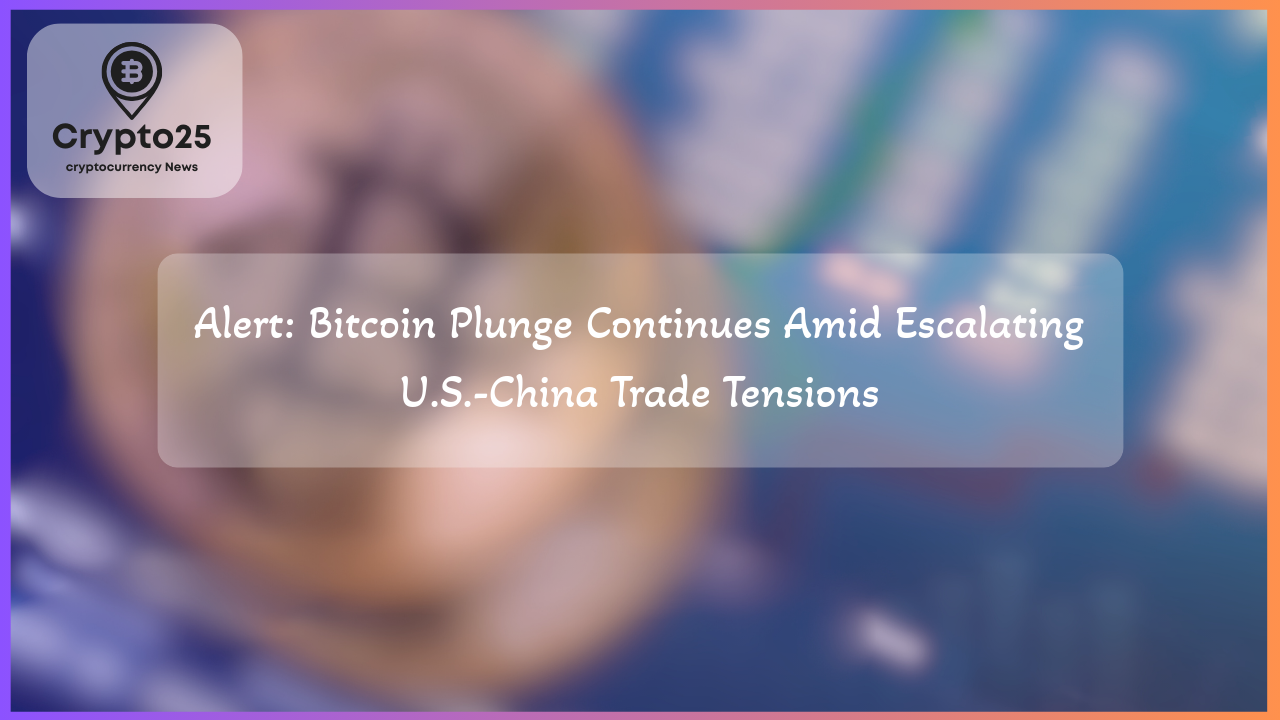
Cryptocurrency markets are seeing a broad decline, reflecting a general aversion to risk assets amidst heightened U.S.-China trade tensions. Bitcoin (BTC) and other key digital assets have experienced a drop following the announcement of increased tariffs and export restrictions imposed by the U.S., leading to market volatility. This shift comes as cryptocurrency risks are being repriced across global markets.
## U.S.-China Trade Tensions Weigh on Bitcoin Price
The cryptocurrency market, highlighted by the performance of Bitcoin, has entered a turbulent phase due to ongoing geopolitical uncertainties. In the last 24 hours, Bitcoin’s value fell by over 2.2%, slipping below its 200-day simple moving average—often seen as a critical indicator of market momentum. The CoinDesk 20 Index, which tracks the performance of top-traded cryptos, recorded a steeper 3.75% decrease. These declines mirror broader sell-offs in traditional equities, with the Nasdaq 100 and S&P 500 futures also registering losses of 1.18% and 0.65%, respectively. Experts suggest that traders may be reconsidering their positions, as Bitcoin heads closer to what some are calling a bear cycle.
This episode reflects a growing interplay between macroeconomic developments and cryptocurrency markets. The White House recently imposed up to 245% tariffs on imports from China, coinciding with export restrictions on semiconductors. Meanwhile, institutional players have started signaling neutral stances on risk factors, leading to subdued price movements. According to Coinbase Institutional, Bitcoin’s decline since late February points to a departure from the recent bull market cycle, emphasizing a more neutral or bearish outlook.
## Crypto Resilience and New Strategic Approaches
Despite the market downturn, some analysts view cryptocurrency’s ability to withstand significant price corrections as a testament to its growing maturity. Jake O., a trader at Wintermute, noted that this durability could support broader adoption of financial hedging strategies among traders. By leveraging premium pricing in spot markets, investors might be better positioned to navigate volatility in the months ahead.
The potential for cryptocurrency to stabilize amid external pressures also signifies a shift in sentiment. Several prime brokers have adjusted their strategies, moving from underweight to neutral on risk assets, driven partly by expectations of upcoming macroeconomic reports. Key data, including U.S. retail sales and unemployment figures, is anticipated in the coming days, which will likely dictate risk sentiment further. Federal Reserve Chair Jerome Powell’s speech on economic trends is another event poised to influence market trajectories. Globally, rates are in focus with the European Central Bank signaling potential rate cuts, creating a mixed macroeconomic backdrop for cryptocurrency traders.
The resilience of the market is mirrored in segments like gold, which saw a year-to-date spike of over 26.5% as traders sought safe-haven assets. Meanwhile, the U.S. Dollar Index declined, reflecting shifts in demand and compounded by geopolitical tensions. This complex economic interplay affirms the importance of data-driven approaches for crypto investors looking for stability.
## Events Shaping the Cryptocurrency Ecosystem
The crypto landscape continues to evolve dynamically, with upcoming developments offering both opportunities and risks for participants. Institutional interest is underscored by events such as Solana (SOL)-linked ETFs launching with staking rewards and layer-1 chains like Pepecoin undergoing their halving events. Governance decisions and token unlocking are pivotal in shaping supply and demand equations for several protocols.
For instance, on April 17, layer-2 solution EigenLayer on Ethereum will activate its slashing mechanism to enhance network security. The same week, BNB Chain’s opBNB mainnet hard fork is expected to streamline its infrastructure. These technical upgrades align with broader ecosystem upgrades, reflecting expanding use cases. Similarly, Arbitrum (ARB) is set to unlock a proportion of its token supply, injecting $25.77M worth of liquidity into its market. Such events often prompt recalibrations by investors around token valuations.
At a macro level, conferences and institutional developments foster crypto-market integration. Asset managers are entering niche markets such as spot Bitcoin ETFs, which are seeing cumulative net inflows of over $35 billion globally. Alongside, stablecoins continue gaining dominance, with $12 billion in transfers recorded last month on the Solana blockchain. USDC, in particular, commands the largest share of the stablecoin market, highlighting its utility amid a backdrop of declining speculative activity in altcoins and memetokens.
## Bitcoin Market Analysis: Key Indicators to Watch
Bitcoin’s momentum indicators suggest bearish undertones as the cryptocurrency trades below critical support levels. The psychological $80,000 price point may act as a turning zone for long-term traders, potentially inviting more short positions if breached. Furthermore, the Ichimoku cloud—a widely regarded momentum tool—continues to provide resistance. Defensive positioning across exchanges like Deribit, with increased emphasis on short-dated options, underscores caution among institutional players.
Meanwhile, declining metrics such as the Z-Score for risk-adjusted performance hint at neutral sentiment in the absence of a clear directional trend. The broader market awaits cues, with policy decisions and forthcoming economic data acting as potential catalysts for futures and spot price movements. Funding rates for contracts like BTC perpetual futures showed limited bullish interest, reflecting broader skepticism.
| Title | Details |
|---|---|
| Market Cap | $1.2 Trillion |
| BTC 24H Change | -2.7% |
| Ethereum Funding Rate | -0.11% |
In conclusion, cryptocurrency markets are adapting to complex global dynamics. Investors should remain vigilant as external forces, such as trade policies and macroeconomic developments, play a growing role in shaping crypto trends. As always, diversification and risk management are critical.
